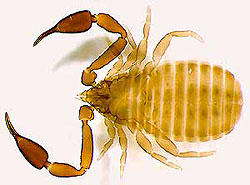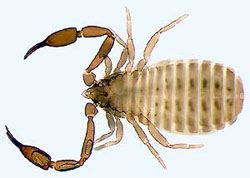|
Pseudoscorpionidae:
false scorpions
|

Synsphyronus niger
|

Synsphyronus absitus |
|
Characteristics
As their
name suggests these animals resemble scorpions in many ways and
although are in the same Class (Arachnida) are not closely related.
They are generally less than 1 centimetre in length and unlike scorpions
are harmless. They have 8 legs like other arachnids and can be distinguished
from scorpions by the following features:
- Abdomen
broadly rounded and lacks a stinging tail
- Pincer-like
appendages with venom glands in most species
Many pseudoscorpions
have a symbiotic
relationship with invertebrates where by they cling to a larger
insect and are transported from one area to another.
Life Cycle
Like scorpions,
some male species of pseudoscorpion grasp the pedipalps
of a female to manoeuvre her over a sperm packet that has been placed
onto the substrate. Other species deposit a sperm packet among leaf
litter or on the underside of a rock for the female to find and
take into her genital opening. The female will then lay her eggs
in a brood-sac that remains attached to her genital opening in which
the embryos are nourished. After hatching the juvenile pseudoscorpions
resemble small adults and will moult
3 times before reaching maturity.
Feeding
Pseudoscorpions
are predators
and feed on other small invertebrates. They subdue their prey be
grasping them with their pincer-like claws and inject them with
venom from glands located in the ends of these claws. They then
chew a hole into the animal and digest the prey preorally.
Habitat
Pseudoscorpions
are common in many terrestrial habitats and are usually found under
leaf litter, in moss, under stones and under the bark of trees.
The flattened body shape of these animals allows them to conceal
themselves in very narrow cracks and crevices. The species Synsphyronus
absitus, shown below was found under the bark of a Eucalyptus tree,
Eucalyptus microtheca in South Australia.
|


